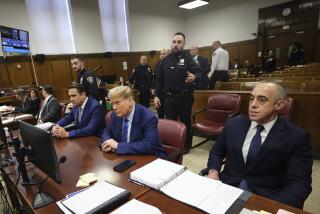Jurors Can’t Even Agree on Disagreements
- Share via
Here’s how far apart the jurors were in the trial of Ronald S. Rubino:
Julia Saakvitne, who thought Rubino should go to jail, complained that most of her fellow jurors were too stupid to hear the case.
“Too much ignorance abounds,” Saakvitne barked as she boarded the courthouse elevator. “It was the composition of the jury. They were not up to deciding this case.”
Meanwhile, Christina Sinclair, who thought Rubino was innocent, called a private meeting with the judge to complain that some of the jurors weren’t giving Rubino a fair trial. After a mistrial was declared, Sinclair left the courtroom in tears and gave Rubino a hug.
“We didn’t feel certain people were going by the law,” she said.
Seven days of pleading, cajoling, shouting and crying did nothing to bridge the chasm that divided the 12-member jury chosen to decide Rubino’s fate.
From the minute they started talking, the group of 11 women and one man was split into two camps: a majority who believed prosecutors had failed to prove their case, and a smaller group--women in their late 60s and 70s--who insisted that Rubino should go to jail.
“They were the self-righteous ones,” said Frances Alsborg, a 49-year-old retired accountant from Villa Park. “We were the stupid ones . . . the young ones.”
Inside the jury room, some jurors wept. Some shouted. One juror cursed, stormed from the room--and returned and changed his vote.
By Friday, the two camps were barely speaking to one another.
“Some people,” said Valerie Greene, who voted for acquittal, “just didn’t understand the law.”
*
Diana Chairez, a real estate agent from Anaheim, never expected such acrimony. On the first day of deliberations, she told a friend: “I’ll see you this afternoon.”
A week later, the jurors said they were so far apart that no amount of persuading was going to solve anything. The final tally: nine to acquit Rubino, three to convict.
According to interviews with several jurors, eight members of the panel thought from the outset that prosecutors had not presented enough evidence to convict Rubino, who was charged with aiding in a scheme to divert millions of dollars from public accounts.
The jurors favoring acquittal said prosecutors had shown them nothing that linked Rubino to the scheme, which involved diverting interest earnings away from schools and cities and into the county treasury.
Central to their belief was the testimony of former Treasurer-Tax Collector Robert L. Citron, who has pleaded guilty to fraud and is awaiting sentencing.
“Citron said he never told Rubino anything,” said Chairez, a real estate agent who lives in Anaheim. “He had no reason to lie. The prosecutors never proved that there was a link.”
Alsborg said she was frustrated that taxpayers--who have already endured the largest municipal bankruptcy in U.S. history--would have to pay for another trial.
“He wasn’t the one,” Alsborg said of Rubino. “He had no power.”
Alsborg said she didn’t believe Rubino would have risked his own career for the sake of merely helping the county’s budget.
“If I were going to steal money, I’d be putting it in my pocket,” she said. “Personally, I felt he was getting banged up for doing his job. I felt very sorry for him.”
Not so for the three jurors who wanted to convict Rubino.
Saakvitne, a Santa Ana public works employee, said Rubino’s own testimony was crucial in her decision to vote for guilt.
“He condemned himself,” she said. “It’s impossible to believe he didn’t know what was going on.”
Saakvitne, 71, said she doesn’t believe the prosecutor could have done anything to sway the other nine jurors. “I didn’t see how they could have ignored the evidence. And they did ignore it. That was the problem.”
Saakvitne said later she was so appalled by the spectacle of jurors hugging the Rubinos afterward that she called for an investigation.
“I was taken aback to observe the defendant’s jubilant wife hugging one of the alternate jurors,” Saakvitne said later in a prepared statement. “They appeared to share their exultation.”
*
Some said that the deadlock was reinforced by the fact that the jury forewoman, Mary Liebschultz, was in the minority to convict.
“Choosing her was a mistake,” Chairez said.
Liebschultz, 72, did not want to talk about the deliberations.
“We did our job,” she said, leaving the courtroom. “We did the best we could.”
After a few days of deliberations, both sides hardened in their positions, and jurors said they saw little hope that anyone would change.
Then, on Thursday, juror Naholowaa Russell Edwards decided to come over to the “not guilty” side.
What ultimately convinced him, Edwards said, was a file of papers Rubino had left behind at the county when he took another job. Prosecutors contended those files showed Rubino’s role in the interest diversion scheme.
“Why would he leave the folder there?” said Edwards, a 28-year-old Anaheim electrician. “Nobody wants to leave a trail to himself.”
Edwards’ reversal prompted a jubilant moment in the otherwise tense deliberations.
“I wanted to jump over the table and hug him,” said Lisa Jeanne Barnes, 26, who favored acquittal. “Why couldn’t the others get it too?”
It was Edwards who, frustrated with the pace of deliberations a few days before, had cursed and stormed from the room. He later apologized to fellow jurors.
“I snapped,” Edwards said. ‘There were tears shed. There was heavy emotion at certain times. It’s a weird kind of case.”
Also contributing to this report were Times staff writers Ken Ellingwood and Davan Mahraj and correspondents Shelby Grad and Jeff Kass.
More to Read
Sign up for Essential California
The most important California stories and recommendations in your inbox every morning.
You may occasionally receive promotional content from the Los Angeles Times.













